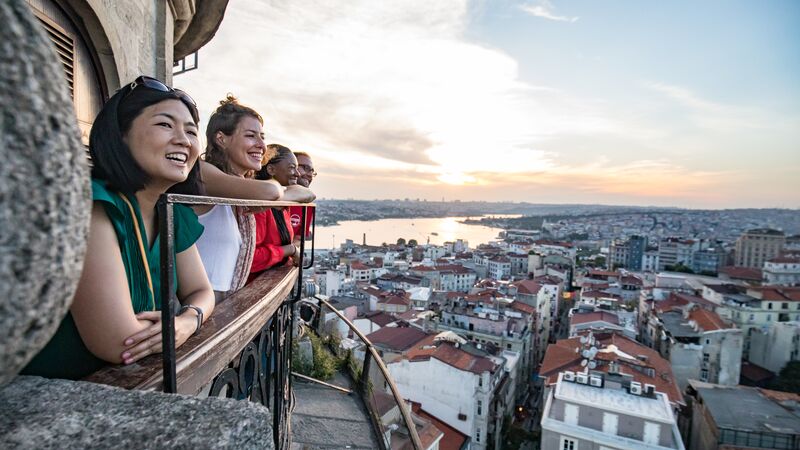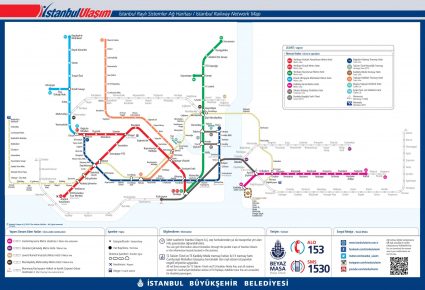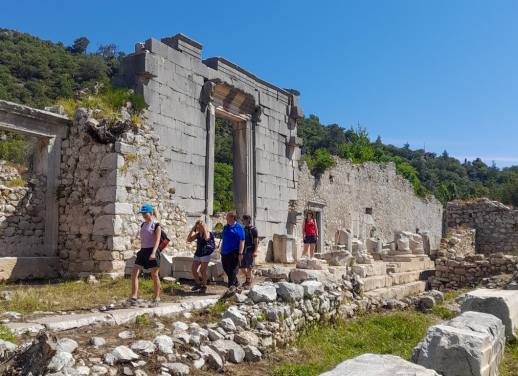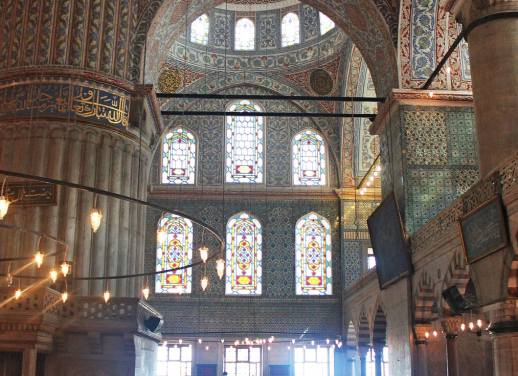Straddling the divide between Europe and Asia, Istanbul is a humming metropolis up there with the best in the world. There are soaring mosques to see, Ottoman-era markets to explore and countless cafes, bars and restaurants to be found hidden in every Byzantine nook and cranny.
But like any major city, a visit to Turkey’s capital can quickly deplete your bank balance if you’re not prepared with a few money-saving tips. At time of publishing, Lonely Planet estimated the average daily cost of visiting to be around USD40 per day, even as high as USD200 in summer season. Make your money travel further with our budget guide to travelling in Istanbul.
Where to stay
Istanbul is divided into European and Asian sides of the Bosphorus Strait, so choosing which side you stay on will depend on what kind of traveller you are and what you’d like to do. For the most part, the Asian side of Istanbul is largely residential. Many of the big attractions, shopping strips and food haunts can be found on the European side of the city. If you want to save time and money on fares travelling back and forth, it’s generally a good idea to stay around two of west Istanbul’s biggest neighbourhoods: Sultanahmet and Beyoğlu (Galata).
What’s the difference between Sultanahmet and Beyoğlu (Galata)? For starters, Sultanahmet is often referred to as Istanbul’s ‘Old City’ and most of the city’s iconic sites can be found here, including Blue Mosque, Hagia Sophia (pictured below) and the Grand Bazaar. There are a number of hotels and hostels in the area but, because of a build-up of tourist hot spots, accommodation here tends towards the pricier side.
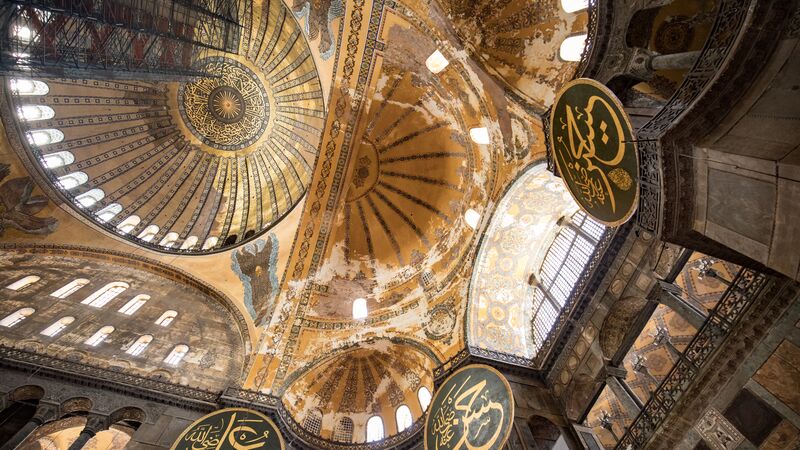
Inside Hagia Sophia, Istanbul.
Just nearby, opposite Sultanahmet on the northern side of the Golden Horn, is Beyoğlu (Galata). Here you’ll find Taksim Square, the famous İstiklal Caddesi boulevard, and Galata Tower. This area has plenty of accommodation options, albeit at a cheaper price.
When it comes to choosing accommodation, consider staying in hostels rather than hotels to get the best price. Sharing dorm rooms with other travellers is a great way to meet people and make friends, as well as save on one of travel’s biggest expenses. Istanbul has plenty of hostels with lots of charm and personality, including some with rooftop views over the city. If you’re looking to stay in Istanbul for a couple of nights and want the accommodation handled for you, Intrepid Travel offers a two-night accommodation and day-tour package.
Getting around
Navigating Istanbul’s tangled city roads can seem overwhelming when you first arrive, but the good news is it’s actually very easy to get around. The city has a sophisticated public transport system, included bus, metro, tram, and boat to help get you to almost every location.
While taking a cab might appeal as the easiest and most straightforward option, it’s also the costliest. The meter rate is expensive and there’s the chance of falling prey to a taxi-related scam, such as overcharging and bill-swapping. Instead, save yourself the headache and buy an Istanbulkart. It’s the Turkish equivalent to London’s Oyster Card, Hong Kong’s Octopus card and Melbourne’s Myki.
Istanbul’s public transport system works on a flat USD1 fare for every single-use paper ticket. There are no zones or grading in the metro system, so it’s the same fare to reach every destination. However, if you purchase an Istanbulkart your single-use rate can drop to around USD.50c – a 50% saving! The card can be used for the metro, buses, trams and funiculars. Note that you must have an Istanbulkart to use the bus in Istanbul as these don’t have cash machines onboard.
You can purchase an Istanbulkart at automated card machines and kiosks found in almost every metro, tram, ferry or metrobus station. You can purchase one at Ataturk airport on arrival at the airport station. The card costs around USD2 but will come pre-loaded for your first fare (around USD1). You can top up your balance as needed at card machines. To use the card, simply ‘tap on’ the reader when entering a metro station or hopping onto a bus or tram.
RELATED STORY: WHAT TO EXPECT ON A STREET FOOD TOUR IN ISTANBUL
Eating out
Street food is a godsend for travellers on a shoestring and Istanbul is one of those cities with a proud street food tradition. Keep an eye out for red-topped carts offering a variety of snacks to keep your energy levels up during the day.
Every cart owner has their own speciality and ‘turf’ to cover in the city. Some traders offer simit (circular sesame-crusted bread rings), poğaça (a crumbly pastry with a variety of fillings), roasted kestane (chestnuts) and köfte ekmek (char-grilled meatballs on bread). Just remember the rules of street food –
- DO go to the more popular carts as higher customer turnover means food is more likely to be fresh.
- DO bring your own hand sanitiser to clean up afterwards.
- DO bring cash to pay for your food as many vendors won’t have touch-on payment systems.
- DON’T judge a book by its cover. A grubby-looking cart doesn’t necessarily mean the food is unsafe. Instead, observe the vendor before purchasing to see how they handle food. Look for signs indicating whether the food has been waiting around for a while, such as being dried out.
- DON’T be tempted to buy mussels from a street stall. It’s better to be safe and buy these from a restaurant.
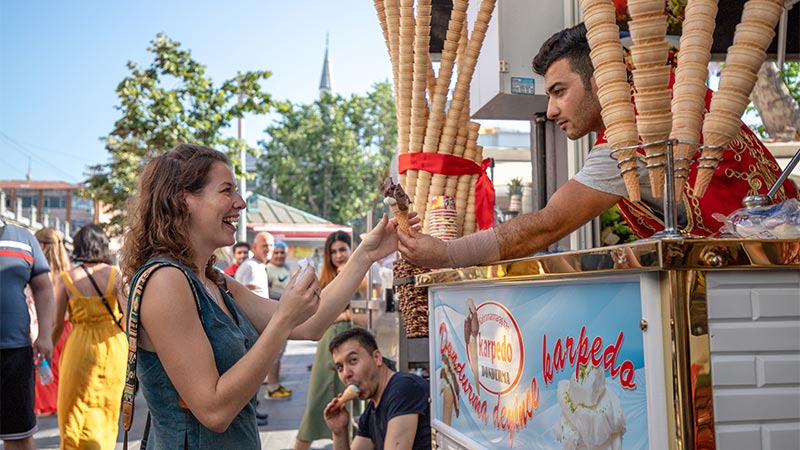
An ice-cream stand in Istanbul, Turkey.
If you’re looking to dine in, keep an eye out for tradesmen restaurants known as esnaf lokantası. These are homely establishments with rotating menus intended for locals, so they’re cheaper than dining at tourist restaurants on the main strips. They’re always open for lunch and sometimes for dinner. You can pick a tradesmen restaurant by its cafeteria-style setting and simple menus. Expect a meal here to set you back about USD4.
Drinking alcohol is relatively more expensive in Turkey compared to other parts of Europe. Beer tends to be cheaper (at around USD5 at a neighbourhood bar) than wine, which is heavily taxed.
If you do choose to eat or drink out, remember tipping is expected at restaurants and bars. Common practice is to tip 10% of the bill at upscale restaurants or 5% at cheaper ones.
Exploring the city
If you play your cards right, it’s possible to spend a day out in Istanbul for practically free. Have a browse of local guides such as Time Out! Istanbul and The Guide Istanbul for regular round ups on what is happening in the city. Other ways to keep entertained include checking out street performances on İstiklal Caddesi boulevard or local musicians performing at metro stations (although remember to give a small tip). Mosques can also be visited for free, provided you are respectful and visit outside main prayer times. Many museums have specific times of the day where entrance is free!
One of the best ways to check out the city’s biggest highlights is to buy an Istanbul Museum Pass. For around USD15, it gives you entrance to dozens of top sites including Topkapi Palace, Hagia Sophia, İstanbul Archaeological Museums, İstanbul Mosaic Museum, Museum of Turkish and İslamic Arts, plus discounts on a selection of other museums, shops, restaurants and activities. The Museum Pass is valid for 120 hours so you can cram in as much museum-hopping as possible. In some cases, the Pass can even give you priority access inside, which is especially handy if you’re travelling in summer. To get an idea how much value this pass represents, a visit to Hagia Sophia on its own can cost as much as USD5, so the pass is a great way to bundle and save.
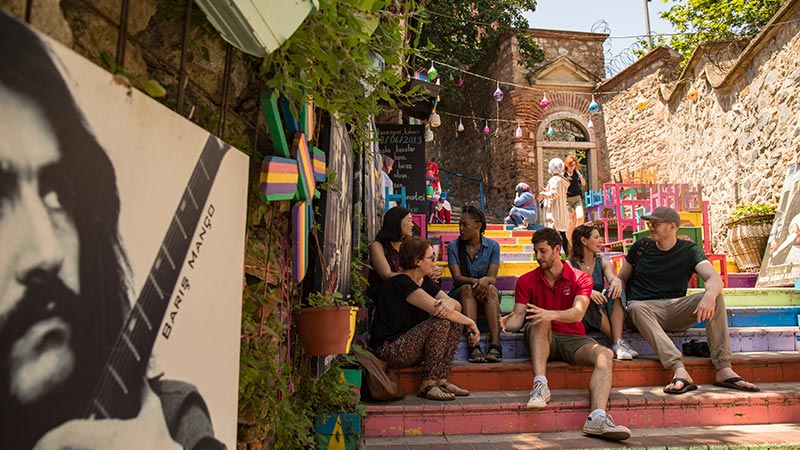
Travellers sitting on colourful steps in Balat, Istanbul.
One popular activity, and a good way to get a sense of the city’s scale, is to jump on a Bosphorus boat tour. These commercial scenic cruises trawl along the straits taking in waterfront highlights such as the 15th-century Rumeli Hisarı fort. While boat tours aren’t necessarily expensive, you can enjoy the same experience simply using your Istanbulkart to pay for a public ferry ride from one end of the strait to the other.
Another way to see the city is to venture to some of the lesser known but equally historic suburbs like Balat. Once the home of Istanbul’s Greek and Jewish population, this brightly coloured suburb has been turning heads recently thanks to a recent EU-funded restoration project and the plethora of cafes, music spots, markets and restaurants that now crowd the narrow streets. It’s an easy place to get lost while discovering ancient churches and synagogues. Check out our detailed guide to Balat here.
RELATED STORY: WHAT TO DO IN ISTANBUL, FROM MUST-DOS TO LESSER KNOWN GEMS
Even more ways to save
- Travel off peak: You can expect accommodation prices to soar during the summer high season from June to August. Avoid the costs, and the crowds, by travelling during shoulder or low season (November to March). Seeing icons like Blue Mosque and Hagia Sophia under a layer of powdery snow is spectacular and a unique way to see this popular city.
- Pay in the local currency: Many businesses in Istanbul accept payment in euro, but it’s better to pay using the Turkish lira as the exchange rate will work in your favour. Currency changers are easy to find in the city, typically clustered around major sites and shopping areas like the Grand Bazaar and Sultanahmet. Another option is to pay on card (if your bank has a good conversion rate) or to withdraw lira from ATMs.
- Haggle your heart out: Turkey has a great bartering culture and haggling is expected when shopping at bazaars. Be prepared to drive a hard bargain but remember to be fair. A good starting point is to halve the price and see how the vendor responds. Remember to never take it too seriously, and that sometimes a well-timed joke or smile can be the difference between making a deal or walking away empty-handed. Knowing a little bit of Turkish can go a long way too.

